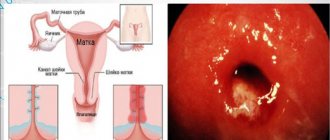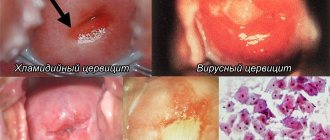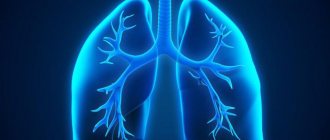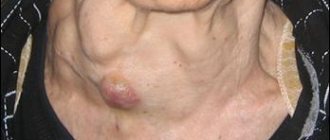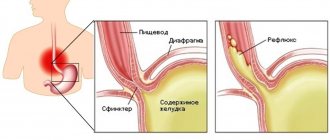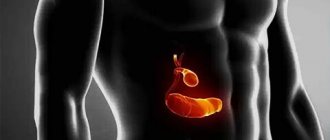Dysmenorrhea is a pathological process characterized by severe pain during menstruation, which is absent throughout the rest of the cycle. There are two types of disorders: primary dysmenorrhea and secondary dysmenorrhea. Primary dysmenorrhea is diagnosed in cases where the causes of painful menstruation are not identified. Dysmenorrhea develops in 45-60% of women of childbearing age. Dysmenorrhea may first appear in the first ovulatory menstrual cycle, significantly reducing a woman’s level of vital activity and performance. Dysmenorrhea is more common in women of asthenic build, prone to loss of consciousness, and easily excitable. The disease is also typical for patients with vegetative-vascular dystonia and astheno-neurotic syndrome.
Causes of dysmenorrhea
The main causes of dysmenorrhea:
- congenital defects that appear as a result of exposure to negative factors during the period of intrauterine development of the fetus - a closed accessory vagina, a closed uterine horn. During menstruation, blood accumulates in the accessory structures, causing intense pain. Sometimes such formations reach quite large sizes, the pain becomes very severe and is even accompanied by a short-term loss of consciousness. The intensity of the pain increases with each menstrual cycle, forcing the patient to see a doctor;
- spasm of the smooth muscles of the uterine body, caused by deviations in the synthesis and metabolism of prostaglandins and thromboxanes. These are biologically active substances that are produced in almost all organs and structures. Some of them are the main mediators of pain and inflammation, others regulate the tone of smooth muscles, and others are responsible for the condition of the microvasculature. By acting on the myometrium, prostaglandins provoke intense contraction of myocytes, which is externally manifested by severe pain. It should be noted that pathological abnormalities can be either congenital or acquired;
- hormonal imbalance, especially excess estrogen in combination with progesterone deficiency. Estrogen is produced by the ovaries; the corpus luteum, which appears after ovulation at the site of the burst follicle, is responsible for the production of progesterone. An increased amount of estrogen increases myometrial spasm, which leads to pain;
- endometriosis (read what it is here) is a gynecological nosology of a chronic nature, which is manifested by the appearance of pathological foci of endometrioid tissue. These lesions, like the normal inner lining of the uterus, are susceptible to cyclic changes - in the first half they grow, in the second they are rejected. The process is accompanied by the accumulation of blood, the development of inflammation and the formation of adhesions in the affected area;
- ovarian tumors, especially those producing hormonal substances;
- fibroids are benign neoplasms of the uterus that develop from the myometrium. This is one of the most common gynecological diseases. According to statistics, fibroids are diagnosed in every fourth woman. The main symptom of fibroids is heavy and prolonged periods, often with the release of blood clots. The pain is cramping in nature, reminiscent of a feeling of heaviness. If the fibroid is located close to the peritoneum, dyspepsia and severe pain in the entire abdomen often occur;
- an incorrectly installed or misaligned spiral is a structure made of a polymer material with the addition of metal. This is a reliable means for preventing unwanted pregnancy, which is installed in the uterine cavity. If for some reason the IUD has moved, or was initially installed incorrectly, it can cause severe menstrual pain and intense bleeding;
- varicose veins of the small pelvis, accompanied by inflammation;
- diseases of the reproductive system of an infectious nature - endometritis (inflammation of the endometrium), salpingitis (inflammation of the fallopian tubes), adnexitis (inflammation of the fallopian tubes and ovaries). Most often, these processes are provoked by pathogenic microflora, infection of which occurs through unprotected sexual contact. When the ovaries are involved, in addition to direct inflammation, there is a disruption in the production of hormones;
- formation of adhesions in the pelvis. Adhesions are rather dense formations, peculiar cords, consisting mainly of collagen fibers. By preventing the normal contraction and relaxation of the uterus during menstruation, adhesions cause quite intense pain (read more here);
- incorrect position of the uterus, as a result of which expulsion of the functional layer of the endometrium and bleeding is difficult;
- delayed sexual development, genital infantilism;
- suffered injuries to the genital organs.
Depending on the cause, dysmenorrhea is of two types - primary and secondary.
Menorrhagia
Menorrhagia, or hypermenorrhea, is excessive and prolonged menstrual bleeding. The average blood loss during menstruation is about 35 ml. If blood loss exceeds 80 ml in 1 menstrual cycle, menorrhagia is diagnosed. Patients with menorrhagia may complain of a feeling of bleeding and the loss of large clots. To clarify the diagnosis of menorrhagia, use the method of counting menstrual pads (changing pads hourly, or 24 pads per day).
An objective gynecological examination, pelvic ultrasonography and endometrial biopsy can determine the possible causes of menorrhagia. With an objective examination, it is important to exclude the possibility of bleeding from the vagina, cervix and rectum. In case of excessive bleeding, blood coagulation factor studies are performed.
Menorrhagia can develop in the presence of uterine fibroids, adenomyosis, endometrial hyperplasia and polyp, endometrial and cervical cancer, dysfunctional uterine bleeding, primary coagulation disorders and as a result of complications associated with pregnancy.
Primary dysmenorrhea
This is a functional disease, manifested by a typical clinical picture without pathologies of the reproductive system. It usually appears at a young age, several years after the start of the first menstruation. As a rule, the pain is minor at first, but the condition worsens every year. The lower abdomen begins to hurt on the first day of menstruation, or a few hours before it begins. The duration of discomfort varies from 1 to 3–4 days. The reasons for this condition are not known exactly, however, there are assumptions that primary dysmenorrhea occurs due to the action of biologically active substances produced in dead endometrial cells - prostaglandins E2 and E2-α.
Statistics
Today there is statistical data showing that dysmenorrhea occurs in 43-90% of all women. This condition is very difficult for 45% of all respondents. Women regularly suffer from severe pain; due to ailments and general weakness, they may partially or completely lose their ability to work during menstruation.
35% of women experience moderate symptoms. They feel unwell, but can cope with it. In 20% of respondents, these symptoms manifest themselves in a mild form. The woman does not lose her ability to work, and practically does not feel any discomfort during this period.
Experts noted that the severity of the manifestation of this condition depends on the social status of the woman, the conditions where she works, and the individual characteristics of her character.
Secondary dysmenorrhea
It is caused by pathological changes in the pelvic organs, such as developmental anomalies, inflammatory processes, etc. The presence of an intrauterine device may also be a cause. Most often, clinical manifestations of the secondary process appear after 30–35 years. Pain and other symptoms of dysmenorrhea usually begin 2-4 days before the start of menstruation and may continue even after it ends. The causes are disturbances in blood flow to the pelvic organs, as well as stretching of the walls of the uterus, myometrial spasms and pathological changes in tissue. Secondary dysmenorrhea can be distinguished from primary dysmenorrhea by the presence of concomitant symptoms of the underlying pathology, as well as during examination by a gynecologist.
Pelvic adhesions
Patients who have a history of pelvic infections, including cervicitis, inflammatory and pelvic diseases, tubo-ovarian abscesses, may have symptoms of dysmenorrhea due to secondary adhesions in the pelvis and abdominal cavity. Patients with other local inflammatory and adhesive processes (appendicitis, endometriosis, Crohn's disease) or previous pelvic surgery may have adhesions of the pelvic organs and secondary dysmenorrhea.
The diagnosis is based on anamnesis, objective (gynecological) examination (fixed, immobile uterus, conglomerate of the uterus and appendages) and is confirmed by the results of exploratory laparoscopy.
Treatment . Patients with secondary dysmenorrhea due to pelvic adhesions may sometimes be exposed to antiprostaglandin drugs, as in primary amenorrhea. In more severe cases and when drug therapy for dysmenorrhea is ineffective, laparoscopy is indicated. During laparoscopy, the diagnosis of pelvic adhesions is confirmed and, if possible, their surgical removal (adhesiolysis) is performed. But in some cases, surgery can contribute to the recurrent development of adhesions and the restoration of problems associated with dysmenorrhea. Methods for the prevention and treatment of adhesions are being developed using intraoperative injection of anti-adhesive solutions and materials into the abdominal cavity.
Signs and symptoms of dysmenorrhea
The main symptom is pain in the abdominal area, mainly lower. This condition is called algomenorrhea. The pain can be aching, pulling or cramping. Often there are changes in the general condition, manifested in the form of weakness, dizziness, nausea, bloating, increased body temperature and loss of appetite. Such symptoms of dysmenorrhea can be severe, which significantly impairs the physical and mental state of a woman.
Approximately 15% of women are forced to take sick leave in the first 1–3 days of menstruation.
With secondary dysmenorrhea, the above symptoms are accompanied by signs of the underlying pathology that caused the cycle disruption.
Classification
Dysmenorrhea in the generally accepted classification is distinguished:
- The primary form of pathology or spastic dysmenorrhea. Its occurrence is not associated with the presence of pathological abnormalities or diseases in a woman’s body. Its appearance is associated with existing disorders of neurohumoral regulation. In turn, primary dysmenorrhea is divided according to the type of occurrence:
- pathology of an essential nature - its occurrence may be associated with the individual characteristics of the woman’s body, other reasons cannot be established. Another theory for the occurrence of this condition is a low threshold of pain sensitivity;
- pathology of a psychogenic nature - pathology is associated with the peculiarities of the functioning of a woman’s uneven system. Before menstruation, anxiety and unreasonable fears arise. Pathology is more often diagnosed in young girls. Subconsciously, they prepare for the onset of menstruation, but feel fear of this process. This condition is typical for adult women with a hysterical, sensitive personality type. Women who have been diagnosed with astheno-vegetative syndrome and other psychopathological conditions are also at risk;
- spasmodic pathology - its cause is spasms of the smooth muscles of the uterus.
- Secondary dysmenorrhea occurs due to malformations of internal organs in the body. With this form of dysmenorrhea, there may be inflammatory diseases of the reproductive system, and there is a violation of the proper functioning of the hormonal system. In this case, pathology is one of the symptoms indicating the main disease developing in the body.
There is also a classification based on the rate of progression of the pathology:
- Compensated - in this case, the symptoms of the pathology do not increase in intensity after the first manifestation. They remain the same for many years.
- Decompensated - the symptoms of this form of pathology gradually increase. This happens gradually, but the woman notices that the pain and other uncomfortable sensations intensify.
Diagnosis of dysmenorrhea
Typically, diagnosing dysmenorrhea is not difficult, since women independently describe all clinical manifestations. The presence of secondary dysmenorrhea can be detected by undergoing an examination by a gynecologist and a series of laboratory and instrumental tests. The most informative in terms of diagnosing dysmenorrhea are:
- laboratory determination of hormone levels in the blood in different phases of the cycle;
- ultrasonography;
- endoscopic examination - colposcopy, hysteroscopy;
- computed tomography or magnetic resonance imaging.
Laboratory determination of hormones in different phases gives the doctor an idea of the regularity of the cycle, the functioning of the ovaries, hypothalamus and pituitary gland, and thyroid gland.
Expert opinion of a doctor
Barakhoeva Zarema Bekhanovna
Reproductologist, obstetrician-gynecologist, Ph.D.
During an ultrasound examination, you can see an incorrectly located uterus, tumors, adhesions, and a displaced helix. Hysteroscopy helps diagnose endometriosis, endometrial polyps and other disorders of the lining of the uterus. CT and MRI are prescribed in doubtful cases, mainly for differential diagnosis. If a tumor is suspected, a biopsy and pathomorphological examination of the obtained material is indicated. Such a diagnosis of dysmenorrhea will make it possible to make a correct final diagnosis, practically eliminating the possibility of error.
Treatment of dysmenorrhea
Regardless of the reasons and the age at which the diagnosis was made, dysmenorrhea requires treatment, first of all, to alleviate the woman’s general condition, as well as to prevent disability. Treatment of primary dysmenorrhea involves taking medications aimed at blocking the action of prostaglandins. These include non-steroidal anti-inflammatory drugs such as Ibuprofen, Naproxen, Diclovit and Nimesulide. These medications also have an analgesic effect. Combined oral contraceptives have a good effect. In case of significant pain, it is possible to take analgesics or antispasmodics (Analgin, Sedalgin and No-shpa)
Sometimes a preventive course is prescribed - taking anti-inflammatory drugs 3-5 days before the onset of menstruation.
The duration of such treatment is 3 menstrual cycles. Treatment of dysmenorrhea as a secondary phenomenon is aimed at treating the underlying gynecological pathology that caused this manifestation. Analgesics are prescribed to eliminate pain and alleviate the general condition. The choice of drug, dosage and methods of use are determined by the doctor after interviewing and examining the patient.
Particular attention is paid to physiotherapeutic procedures. Relaxing baths with extracts of pine needles, mint and lemon balm normalize the functioning of the central nervous system. A course of 10–15 baths is enough to stabilize the central nervous system. Electrosleep has a similar effect. Ultratonotherapy improves blood supply to internal organs, normalizes the tone of blood and lymphatic vessels, and improves metabolism. Sunbathing also has a noticeable effect. Sun rays improve the functioning of the immune system, activate regenerative processes, and normalize metabolism. The procedures are recommended to be taken in the morning and evening hours. Electrical stimulation of the cervix allows you to regulate the functioning of the hypothalamic-pituitary system by activating peripheral receptors and triggering reflex reactions. If necessary, the patient is recommended psychotherapy sessions. These can be both group and individual sessions, the type of which is selected by the psychotherapist.
Premenstrual syndrome
Premenstrual syndrome is a collection of symptoms that occur during the second half of the menstrual cycle and include weight gain, acne, hot flashes, swelling, diarrhea or constipation, mood swings, breast tenderness and hardness, and depressive symptoms. About 90% of women may have symptoms of premenstrual syndrome (PMS), 5% of them lose their ability to work during the corresponding days of the menstrual cycle.
Pathogenesis . The exact mechanism of development of PMS is unknown, but its numerous physiological and psychological causes have been established. The most common hypotheses for the pathogenesis of PMS include estrogen-progesterone imbalance (progesterone deficiency), hyperprolactinemia, fluctuations in steroid hormone levels, disorders of the renin-angiotensin-aldosterone system and electrolyte balance, vasopressin; excessive production of prostaglandins; impaired synthesis of neurotransmitters (monoamines, acetylcholine), other hormones (androgens, glucocorticoids, melatonin and insulin), decreased endogenous synthesis of endorphins or impaired sensitivity of receptors to endogenous opiates. Modern theories of the pathogenesis of PMS prefer a violation of serotonin secretion as a primary or secondary cause of the development of this syndrome.
Assuming normal metabolism, serotonin levels rise and fall throughout the day. An increase in serotonin levels is accompanied by a need for protein intake; the drop in serotonin levels then begins a new cycle. With PMS, serotonin levels do not reach the trigger level for protein consumption, even after eating carbohydrates. So, patients with PMS tend to increase their consumption of sweets.
The administration of progesterone, the deficiency of which was previously considered responsible for the development of PMS, helps only a small proportion of patients, and in many cases can worsen the condition of patients. Progesterone helps increase plasma levels of MAO (MAO) during the menstrual cycle. According to one theory, an increase in MAO levels correlates with the development of depression due to catecholamine deficiency. Symptoms of fluid retention (weight gain, swelling, breast hardening) with PMS, as well as some emotional symptoms, may be associated with increased levels of renin, angiotensin and aldosterone. A direct aldosterone antagonist, spironolactone (veroshpiron), usually reduces the symptoms of PMS.
Treatment of premenstrual syndrome is often carried out by exclusion - if one group of drugs is ineffective, other treatment options are prescribed. In 1/3 of patients with premenstrual syndrome, significant improvement is achieved through the use of an adequate diet. The diet consists of reducing the consumption of simple carbohydrates (sugar) in favor of complex ones (fruits, vegetables), reducing salt, fat, but sufficiently consuming proteins. In order to increase the production of endogenous opiates, dosed physical exercise is recommended. In some cases, homeopathic medicines (Dysmenorm, Menalgin, Remens, etc.) can be effective.
Nonsteroidal anti-inflammatory drugs reduce the production and effects of prostaglandins and may also be effective. For pain and hardening of the mammary glands, it is recommended to prescribe bromocriptine at a dose of 5 mg/day. Oral contraceptives usually reduce the manifestations of premenstrual syndrome by blocking ovulation and suppressing the endometrium (reducing the synthesis of prostaglandins), as well as normalizing the estrogen-progestin ratio.
The theory of the development of premenstrual syndrome due to fluctuations in the level of steroid hormones has been confirmed in a number of studies on the effectiveness of GnRH agonists (zoladex, diferelin, decapeptyl, lupron) in reducing the manifestations of PMS.
When significant edema develops, diuretics are used (veroshpiron, Lasix, furosemide). Patients with depressive disorders, loss of appetite, sleep disorders, autistic reactions, and withdrawal from social life may require the prescription of psychotropic drugs - alprazolam (Xanax) and fluoxetine hydrochloride (Prozac).
Prevention of dysmenorrhea
Prevention of dysmenorrhea consists of timely identification and treatment of conditions leading to menstrual irregularities. Prevention of primary dysmenorrhea has not been developed to date.
The main non-specific activities are:
- regular examinations by a gynecologist. With their help, you can make a timely diagnosis of dysmenorrhea, find out its cause and prescribe the necessary treatment. It is recommended to visit a doctor for the first time no later than 16 years of age. With the onset of sexual activity, visits should be scheduled at least once every six months; complete and timely treatment of inflammatory processes that can provoke a variety of complications - dysmenorrhea, irregular cycles and even infertility;
- searching for an alternative to the intrauterine device. Despite the fact that this is a very effective contraceptive that has a long-lasting effect and does not require daily monitoring, it has a number of negative properties and sometimes causes complications. Dysmenorrhea is one of them;
- careful planning of pregnancies, avoiding abortions, performing curettage only for strict medical reasons. Abuse of such interventions is fraught with the development of adhesions, pathological narrowing of the cervical canal, and chronic low-grade inflammation;
- removal of polyps and fibroids in the early stages, when the affected area is minimal and the likelihood of complete recovery is very high.
